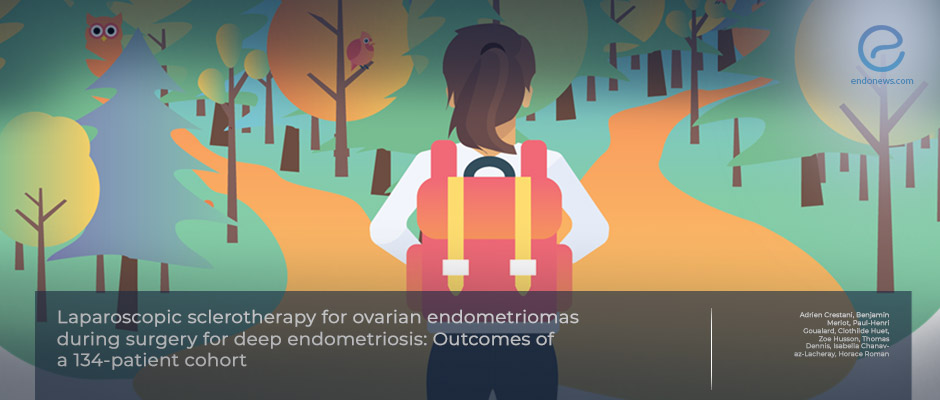Fertility and Recurrence Outcomes After Laparoscopic Ethanol Sclerotherapy for Endometriomas
Nov 13, 2025
Consensus guides deep endometriosis surgery, but endometrioma management remains unresolved.
Key Points
Highlights:
-
Endometriomas ≥5 cm may be managed with laparoscopic ethanol sclerotherapy as a potential alternative to surgical cystectomy.
Importance:
- Sclerotherapy offers a fertility-preserving, minimally invasive option for managing large endometriomas.
- This study supports its safety and reproductive effectiveness, suggesting it may be a useful alternative when cystectomy poses a higher risk to ovarian reserve.
What’s done here?
- A retrospective cohort study was conducted at the Franco-European Multidisciplinary Endometriosis Institute (IFEMEndo), Bordeaux, France.
- Included 134 patients who underwent laparoscopic resection of deep endometriosis lesions plus ethanol sclerotherapy for endometriomas ≥40 mm.
- Sclerotherapy involved aspiration followed by instillation of 96% ethanol.
- The main outcomes measured were fertility rates, endometrioma recurrence, anti-Müllerian hormone (AMH) levels, and postoperative complications.
- A total of 78 patients expressed a desire to conceive postoperatively and were included in the fertility outcome analysis.
Key results:
- Preoperative AMH levels averaged 2.96±2.02 ng/mL and decreased significantly postoperatively.
- Of the 78 patients attempting conception, 45 (57%) achieved pregnancy, including 19 (42%) spontaneous pregnancies.
- The mean time to pregnancy was 13±9 months; the cumulative live birth rates were 47% (24 m) and 57% (36 m).
- Cumulative pregnancy rates were 55.5% at 24 months and 78.8% at 36 months.
- Predictors of pregnancy included higher preoperative AMH levels and absence of prior abdominal surgery.
- Recurrence of endometriomas occurred in 17 (16.5%) patients over a median follow-up of 23 months.
- Only 2 (1.5%) patients required repeat ovarian surgery.
Strengths and Limitations:
- A relatively large cohort with robust follow-up, with more than 70% of patients monitored for at least 2 years are strengths of the study.
- Limitations are: Lack of a comparison group (e.g., cystectomy or expectant management) limits causal conclusions, and the retrospective design introduces inherent selection and reporting bias.
From the Editor-in-Chief – EndoNews
"The management of ovarian endometriomas continues to challenge clinicians who must balance fertility preservation, recurrence risk, and surgical morbidity. This study contributes meaningful real-world data supporting the safety and reproductive adequacy of ethanol sclerotherapy performed alongside deep endometriosis surgery. With pregnancy achieved in more than half of the women attempting conception—and a substantial proportion conceiving spontaneously—the technique demonstrates promising potential for selected patients.
Yet, while these results deserve recognition, they must be interpreted within the broader clinical landscape. Excisional cystectomy remains the reference standard for endometrioma treatment, not only because of its superior recurrence profile but also because it allows histopathologic confirmation. This is particularly relevant given the well-documented, albeit low, risk of malignant transformation in endometriotic cysts, especially in women over 40 even in the absence of atypical imaging features. Ablative techniques, including ethanol sclerotherapy, do not provide tissue for diagnosis and therefore cannot exclude occult atypia or early neoplastic change.
For carefully selected younger patients prioritizing fertility, however, the trade-off may be acceptable—especially when the procedure is performed in a center with expertise in deep endometriosis surgery and rigorous preoperative imaging assessment. In this context, sclerotherapy offers a practical, minimally invasive option that limits surgical trauma to ovarian tissue.
Ultimately, what this study reinforces is not a shift in standard of care but the growing recognition that endometrioma management must be individualized. Technique selection should incorporate ovarian reserve, reproductive plans, prior surgeries, recurrence risk, and—critically—oncologic safety. As the authors rightly note, prospective and randomized trials are essential before ethanol sclerotherapy can be considered a reliable alternative to cystectomy."
Lay Summary
Ethanol sclerotherapy is a minimally invasive approach for treating ovarian endometriomas and is sometimes used as an alternative to surgical cystectomy, particularly when preservation of ovarian reserve is a priority. Instead of removing the cyst wall, the technique involves aspirating the cyst contents and instilling 95–100% ethanol to ablate the lining, with the goal of minimizing damage to healthy ovarian tissue. It is typically considered for larger or recurrent cysts and has a generally favorable safety profile, although recurrence and incomplete sclerosis remain potential concerns.
In a study published in the International Journal of Gynecology & Obstetrics, Crestani et al. evaluated outcomes in 134 women undergoing minimally invasive surgery for deep endometriosis under the leadership of Dr. Roman, during which ethanol sclerotherapy was used to treat endometriomas measuring 40 mm or larger. The investigators aimed to assess postoperative fertility, changes in ovarian reserve, and the likelihood of cyst recurrence.
Among the 78 women wishing to conceive, 57% became pregnant, and more than 40% of these pregnancies were spontaneous, without assisted reproductive techniques. Although AMH levels decreased postoperatively—a known limitation of any ovarian intervention—the recurrence rate was relatively low at 16.5%, and only two patients (1.5%) required repeat ovarian surgery. No severe complications were attributed to the ethanol instillation.
The authors conclude that ethanol sclerotherapy, when performed in conjunction with deep endometriosis surgery, appears to be a safe and promising fertility-preserving option, though they emphasize the need for future randomized trials to determine whether it is superior to cystectomy.
Research Source: https://pubmed.ncbi.nlm.nih.gov/40332134/
endometriosis anti-Müllerian hormone endometrioma deep endometriosis sclerotherapy laparoscopy ovarian reserve

